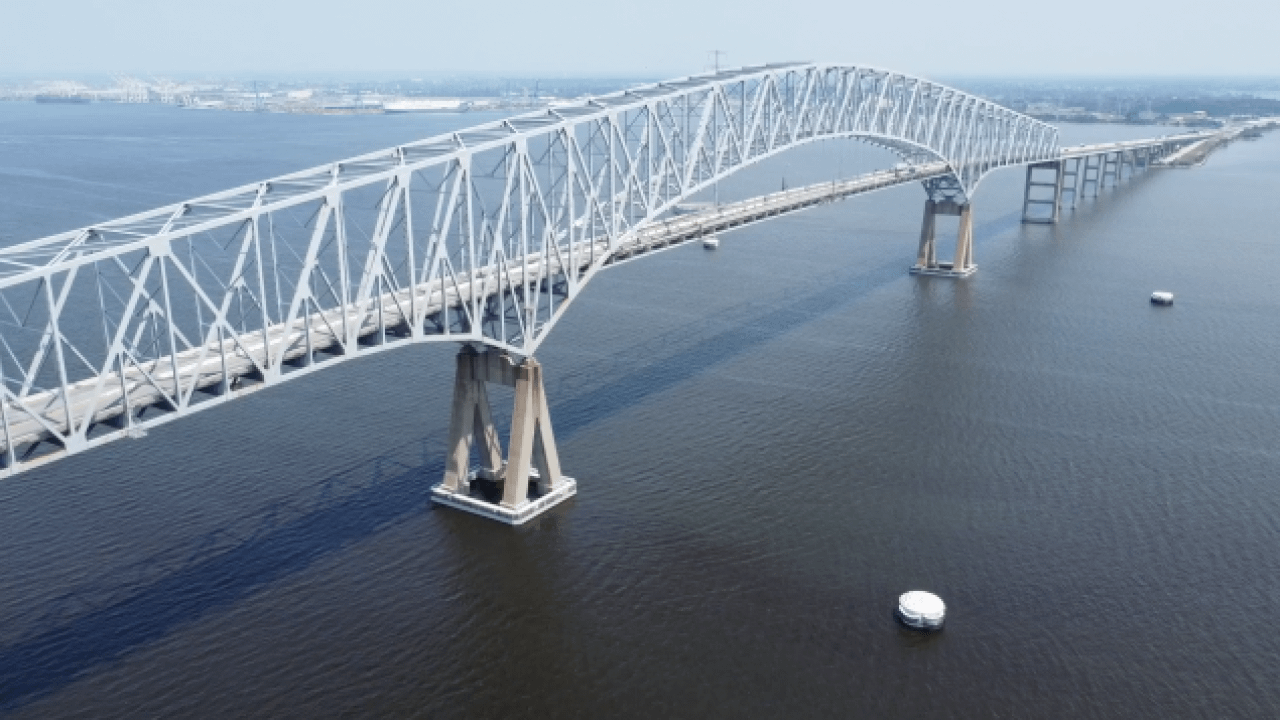The Francis Scott Key Bridge, commonly known as the Key Bridge, is a prominent landmark and vital transportation link spanning the Patapsco River in Baltimore, Maryland. Tragedy struck in Baltimore on 26th March morning when this bridge collapsed after being struck by a container ship, leading to the deaths of six individuals and the closure of one of the nation’s busiest ports. Here’s a brief overview of its history and significance:
Did you know? Key Bridge is named after Francis Scott Key, the guy who wrote “The Star-Spangled Banner.” You know, that song we sing at big events like ballgames? Well, he wrote it after seeing a battle at Fort McHenry during the War of 1812.

Construction
The Key Bridge was completed in 1977 and opened to traffic as the “Outer Harbor Crossing”. The bridge was constructed to alleviate traffic congestion on existing river crossings and provide a direct route between Baltimore County and Anne Arundel County.
This helped in connecting Hawkins Point in Baltimore to Sollers Point in Dundalk, all the way across the Patapsco River. This river was super important for ships, giving them access to the busy Port of Baltimore.
Design and Features
The Key Bridge is a steel through-arch bridge with a total length of approximately 1.6 miles long. It consists of two parallel spans, each carrying three lanes of traffic in one direction.
The bridge’s distinctive arches rise gracefully above the river, providing a visually striking and iconic silhouette against the Baltimore skyline.
Transportation Link
The Key Bridge serves as a vital transportation artery, connecting the communities of Baltimore City, Baltimore County, and Anne Arundel County. It carries Interstate 695, also known as the Baltimore Beltway, which encircles the city of Baltimore. The bridge plays a crucial role in facilitating the movement of goods, commuters, and travelers within the region.
Every day, around 34,000 vehicles zoomed across it, making it a pretty busy spot. Even though it had a run-in with a cargo ship back in 1980, the bridge came out pretty okay, still helping people get where they needed to go without too much trouble.
Economic Impact
The Key Bridge has contributed to the economic development and growth of the Baltimore metropolitan area by improving access to key industrial, commercial, and residential areas. Its efficient transportation corridor supports businesses, industries, and employment centers on both sides of the river, enhancing regional connectivity and mobility.
In 2023, this port handled tons of cargo – over 52 million tons, to be exact, worth about $80 billion! That’s a whole lot of stuff, including around 750,000 cars. And get this, it also provided jobs for around 15,000 folks directly and helped support about 140,000 more jobs indirectly.
Maintenance and Upgrades
Like any major infrastructure asset, the Key Bridge requires regular maintenance, inspection, and occasional upgrades to ensure its continued safety and functionality. Routine maintenance activities include painting, structural repairs, and deck rehabilitation to address wear and tear from traffic, weather, and environmental factors.
Cultural and Historical Significance
In addition to its practical importance as a transportation link, the Key Bridge holds cultural and historical significance as a symbol of Baltimore’s identity and heritage. Named after a prominent figure in American history, the bridge embodies the spirit of resilience, patriotism, and community pride that characterizes the city and its residents.
Overall, the Francis Scott Key Bridge stands as a symbol of progress, connectivity, and unity for the people of Baltimore and the surrounding region. Its graceful design, essential role in transportation, and historical significance make it a beloved landmark and integral part of the city’s infrastructure.
Significance & Impact of the Key Bridge
- Tribute to a Hero: The Key Bridge is named after Francis Scott Key, the guy who wrote “The Star-Spangled Banner.” You know, that song we sing at big events like ballgames? Well, he wrote it after seeing a battle at Fort McHenry during the War of 1812.
- Handy Connection: This bridge is like a big link between different parts of Baltimore. It stretches across the Patapsco River, connecting areas in Baltimore County and Anne Arundel County. So, if you need to get from one side of town to the other, this bridge is your go-to.
- Traffic Helper: Ever been stuck in bumper-to-bumper traffic? Yeah, not fun. The Key Bridge helps ease that congestion by giving folks another way to cross the river. It takes some pressure off other busy routes like the Baltimore Harbor Tunnel.
- Pretty Picture: Have you seen this bridge? It’s pretty cool-looking with its big arches and wide spans. It’s like a landmark in Baltimore’s skyline, adding to the city’s charm and reminding us of its maritime history.
- Money Mover: Believe it or not, this bridge is a big deal for business. It helps companies move their goods around and supports trade at the Port of Baltimore, which is a major player on the East Coast. So, it’s not just a bridge; it’s an economic engine.
- Hometown Pride: Lastly, the Key Bridge is part of Baltimore’s identity. It’s named after a local hero, Francis Scott Key, and it’s a reminder of our city’s role in American history. It’s something we can all be proud of.
- So, the Francis Scott Key Bridge isn’t just a way to get from point A to point B. It’s a symbol of Baltimore’s past, present, and future, and it’s something that makes our city special.
Overall, the Francis Scott Key Bridge is more than just a structure for crossing the river; it embodies the spirit of Baltimore and serves as a testament to the city’s enduring legacy, resilience, and contributions to the nation’s heritage.
